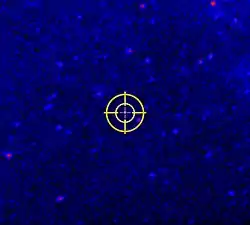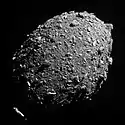PSR J0952–0607
PSR J0952–0607 is a massive millisecond pulsar in a binary system, located between 3,200–5,700 light-years (970–1,740 pc) away from Earth in the constellation Sextans.[5] It holds the record for being the most massive neutron star known as of 2022, with a mass 2.35±0.17 times as much as the Sun—potentially close to the Tolman–Oppenheimer–Volkoff mass upper limit for neutron stars.[4][6] The pulsar rotates at a frequency of 707 Hz (1.41 ms period), making it the second-fastest-spinning pulsar known, and the fastest-spinning pulsar that is located in the Milky Way.[7][5]
| Observation data Epoch J2000.0 Equinox J2000.0 | |
|---|---|
| Constellation | Sextans |
| Right ascension | 09h 52m 08.319s[1] |
| Declination | −06° 07′ 23.49″[1] |
| Characteristics | |
| Spectral type | Pulsar |
| Apparent magnitude (i) | 22.0–24.4[2] |
| Astrometry | |
| Distance | 970+1160 −530 pc[3] or 1740+1570 −820 pc[3] or 6260+360 −400 (optical) pc[4] |
| Details | |
| PSR J0952–0607 A | |
| Mass | 2.35±0.17[4] M☉ |
| Rotation | 1.41379836 ms[3] |
| Age | 4.9[3] Gyr |
| PSR J0952–0607 B | |
| Mass | 0.032±0.002[4] M☉ |
| Luminosity | 9.96+1.20 −1.12[lower-alpha 1] L☉ |
| Temperature | 3085+85 −80[4] K |
| Metallicity [Fe/H] | –0.5[2] dex |
| Orbit[3] | |
| Primary | PSR J0952–0607 A |
| Companion | PSR J0952–0607 B |
| Period (P) | 0.267461035 d (6.41906484 h) |
| Semi-major axis (a) | 1600000 km[lower-alpha 2] |
| Eccentricity (e) | <0.004 |
| Inclination (i) | 59.8+2.0 −1.9[4]° |
| Semi-amplitude (K2) (secondary) | 376.1±5.1[4] km/s |
| Other designations | |
PSR J0952–0607, 4FGL J0952.1–0607 | |
| Database references | |
| SIMBAD | data |
PSR J0952–0607 was discovered by the Low-Frequency Array (LOFAR) radio telescope during a search for pulsars in 2016.[5] It is classified as a black widow pulsar, a type of pulsar harboring a closely-orbiting substellar-mass companion that is being ablated by the pulsar's intense high-energy solar winds and gamma-ray emissions.[4][8] The pulsar's high-energy emissions have been detected in gamma-ray and X-ray wavelengths.[9][3][10]
Discovery
PSR J0952–0607 was first identified as an unassociated gamma-ray source detected during the first seven years of the Fermi Gamma-ray Space Telescope's all-sky survey since 2008.[7]: 2 Because of its optimal location away from the crowded Galactic Center and its pulsar-like[11]: 8 gamma-ray emission peak at 1.4 GeV, it was deemed a prime millisecond pulsar candidate for follow-up.[7]: 2 The pulsar was reobserved and confirmed by the Low-Frequency Array (LOFAR) radio telescope in the Netherlands on 25 December 2016, which revealed a 707-Hz radio pulsation frequency alongside radial acceleration by an unseen binary companion.[7]: 3 Further LOFAR observations took place from January to February 2017, alongside radio observations by the Green Bank Telescope in Green Bank, West Virginia in March 2017.[7]: 3 Optical observations by the 2.54-meter Isaac Newton Telescope on La Palma detected and confirmed the pulsar's companion at a faint apparent magnitude of 23 in January 2017.[7]: 3 The discovery was published in The Astrophysical Journal Letters and was announced in a NASA press release in September 2017.[7][5]
Binary system
The PSR J0952–0607 binary system comprises a massive pulsar and a substellar-mass (<0.1 M☉)[8]: 127 companion in close orbit around it.[4] Because of this configuration, this system falls under the category of black widow pulsars that "consume" their companion, by analogy with the mating behavior of the eponymous black widow spider.[6] The companion is continuously losing mass through ablation by intense high-energy solar winds and gamma-ray emissions from the pulsar, which then accretes some of the companion's lost material onto itself.[8]: 127 [4]: 1
Companion

The companion orbits the pulsar at a distance of 1.6 million km (1 million mi)[lower-alpha 2] with an orbital period of 6.42 hours.[4] Because it orbits so closely, the companion is presumably tidally locked, with one hemisphere always facing the pulsar.[3]: 8 The companion does not appear to eclipse the pulsar,[7]: 1 [3]: 12 indicating that its orbit is oriented nearly face-on with an inclination of 60° with respect to the plane perpendicular to Earth's line of sight.[4]: 4 The companion's orbital motion also does not appear to modulate the pulsar's pulsations, signifying a circular orbit with negligible orbital eccentricity.[3]: 4
The companion was likely a former star that had been reduced to the size of a large gas giant planet or brown dwarf,[6][3]: 12 with a present-day mass of 0.032±0.002 M☉ or 34±2 MJ according to radial velocity measurements.[4]: 4 Due to intense irradiation and heating by the host pulsar, the companion's radius is bloated up to 80% of its Roche lobe[3]: 8 [4]: 4 and brightly glows with a thermal luminosity of about 10 L☉,[lower-alpha 1] thereby accounting for much of the system's optical brightness.[4]: 1, 4 [2]: 1 As a result of bloating, the companion attains a low density likely around 10 g/cm3 (with significant uncertainty due to the system's unknown distance from Earth),[2]: 11 making it susceptible to tidal deformation by the pulsar.[3]: 12
The companion's pulsar-facing irradiated hemisphere is continuously heated up to a temperature of 6,200 K, whereas the companion's unirradiated hemisphere experiences a uniform[2]: 4 temperature of 3,000 K.[4]: 4 This hemispherical temperature difference corresponds to a difference in hemisphere luminosities, which in turn causes significant variability in apparent brightness as the companion rotates around the pulsar.[7]: 4 [3]: 8 This brightness variability is demonstrated in PSR J0952–0607's optical light curve, which exhibits an amplitude greater than one magnitude.[2]: 4
Mass
PSR J0952–0607 has a mass of 2.35±0.17 M☉, making it the most massive neutron star known as of 2022.[4] The pulsar likely acquired most of its mass by accreting up to 1 M☉ of lost material from its companion.[4]: 5
Rotation and age
PSR J0952–0607 rotates at a frequency of 707 Hz (1.41 ms period), making it the second-fastest-spinning pulsar known, and the fastest-spinning pulsar that is located in the Milky Way.[7][5] Assuming a standard neutron star radius of 10 km (6.2 mi),[3]: 11 the equator of PSR J0952–0607 rotates at a tangential velocity over 44,400 km/s (27,600 mi/s)—about 14% the speed of light.[12] Based on 7 years of precise pulsation timing data from gamma-ray and radio observations, the pulsar's rotation period is estimated to be slowing down at a spin-down rate less than 4.6×10−21 seconds per second, corresponding to a characteristic age of 4.9 billion years.[3]: 11
Magnetic field
Measurements of PSR J0952–0607's spin-down rate show that the pulsar has a remarkably weak surface magnetic field strength of 6.1×107 gauss (6.1×103 T), placing it among the 10 weakest pulsar magnetic fields known as of 2022.[4]: 1 For context, ordinary pulsar magnetic fields usually lie on the order of teragauss (1×1012 G, 1.0×108 T), over 10,000 times greater than that of PSR J0952–0607.[13][4]: 1 Other millisecond pulsars exhibit similarly weak magnetic fields, hinting at a common albeit unknown mechanism in these types of systems;[3]: 2 possible explanations range from accreted matter burying the pulsar's surface magnetic field to heat-driven evolution of the pulsar's solid crust.[13]: 1–2 [4]: 1
Gamma-ray emissions
PSR J0952–0607 appears very faint in gamma-rays and was not detected in July 2011.[10][3]: 2
See also
- Tolman–Oppenheimer–Volkoff limit
- Black Widow Pulsar, the prototypical namesake for the class of binary pulsars with ablating companions
- PSR J1748−2446ad, the fastest-spinning pulsar located in the globular cluster Terzan 5
Notes
- Luminosity converted from erg/s to L☉, given 3.81+0.46
−0.43×1034 erg/s from Romani et al. (2022)[4] and the solar luminosity L☉ = 3.826×1033 erg/s. - Orbital semi-major axis calculated with Kepler's Third Law: given primary mass = 2.35 M☉ and orbital period = 6.42 h.[4] Nieder et al. (2019) determined a minimum projected semi-major axis of 0.0626670 light seconds (18787 km) from gamma-ray and radio pulsation timing.[3]: 6
References
- "PSR J0952-0607 -- Pulsar". SIMBAD. Centre de données astronomiques de Strasbourg. Retrieved 26 July 2022.
- Draghis, Paul; Romani, Roger W.; Filippenko, Alexei V.; Brink, Thomas G.; Zheng, WeiKang; Halpern, Jules P.; Fernando, Camilo (September 2019). "Multiband Optical Light Curves of Black-widow Pulsars". The Astrophysical Journal. 883 (1): 13. arXiv:1908.00992. Bibcode:2019ApJ...883..108D. doi:10.3847/1538-4357/ab378b. 108.
- Nieder, L.; Clark, C. J.; Bassa, C. G.; Wu, J.; Singh, A.; Donner, J. Y.; et al. (September 2019). "Detection and Timing of Gamma-Ray Pulsations from the 707 Hz Pulsar J0952-0607". The Astrophysical Journal. 883 (1): 17. arXiv:1905.11352. Bibcode:2019ApJ...883...42N. doi:10.3847/1538-4357/ab357e. 42.
- Romani, Roger W.; Kandel, D.; Filippenko, Alexei V.; Brink, Thomas G.; Zheng, WeiKang (August 2022). "PSR J0952-0607: The Fastest and Heaviest Known Galactic Neutron Star". The Astrophysical Journal Letters. 934 (2): 6. arXiv:2207.05124. Bibcode:2022ApJ...934L..17R. doi:10.3847/2041-8213/ac8007. L18.
- Reddy, Francis (5 September 2017). "'Extreme' Telescopes Find the Second-fastest-spinning Pulsar". NASA. Retrieved 26 July 2022.
- Sanders, Robert (26 July 2022). "Heaviest neutron star to date is a 'black widow' eating its mate". Berkeley News. University of California Berkeley. Retrieved 26 July 2022.
- Bassa, C. G.; Pleunis, Z.; Hessels, J. W. T.; Ferrara, E. C.; Breton, R. P.; Gusinskaia, N. V.; et al. (September 2017). "LOFAR Discovery of the Fastest-spinning Millisecond Pulsar in the Galactic Field". The Astrophysical Journal Letters. 846 (2): 7. arXiv:1709.01453. Bibcode:2017ApJ...846L..20B. doi:10.3847/2041-8213/aa8400. L20.
- Roberts, Mallory S. E. (March 2013). "Surrounded by spiders! New black widows and redbacks in the Galactic field". Proceedings of the International Astronomical Union. 291: 127–132. arXiv:1210.6903. Bibcode:2013IAUS..291..127R. doi:10.1017/S174392131202337X.
- Ho, Wynn C. G.; Heinke, Craig O.; Chugunov, Andrey I. (September 2019). "XMM-Newton Detection and Spectrum of the Second Fastest Spinning Pulsar PSR J0952-0607". The Astrophysical Journal. 882 (2): 7. arXiv:1905.12001. Bibcode:2019ApJ...882..128H. doi:10.3847/1538-4357/ab3578. 128.
- Kohler, Susanna (11 December 2019). "An Extreme Pulsar Seen in Gamma Rays". AAS Nova Highlights. American Astronomical Society. Bibcode:2019nova.pres.6048K. Retrieved 26 July 2022.
- Abdollahi, S.; Acero, F.; Ackermann, M.; Ajello, M.; Atwood, W. B.; Axelsson, M.; et al. (March 2020). "Fermi Large Area Telescope Fourth Source Catalog". The Astrophysical Journal Supplement Series. 247 (1): 37. arXiv:1902.10045. Bibcode:2020ApJS..247...33A. doi:10.3847/1538-4365/ab6bcb. 33.
- Starr, Michelle (24 September 2019). "Astronomers Detect Gamma Rays From an Extreme Pulsar Spinning 707 Times Per Second". ScienceAlert. Retrieved 27 July 2022.
- Mukherjee, Dipanjan (September 2017). "Revisiting Field Burial by Accretion onto Neutron Stars". Journal of Astrophysics and Astronomy. 38 (3): 10. arXiv:1709.07332. Bibcode:2017JApA...38...48M. doi:10.1007/s12036-017-9465-6. hdl:1885/247814. 48.


